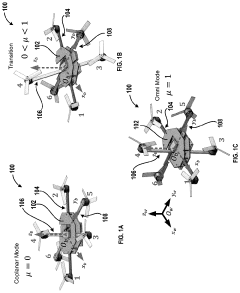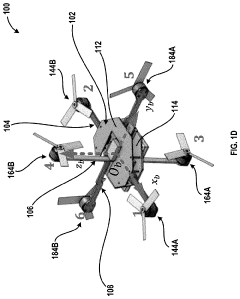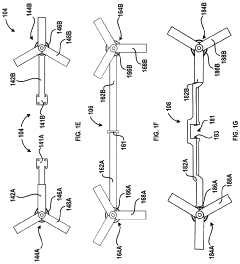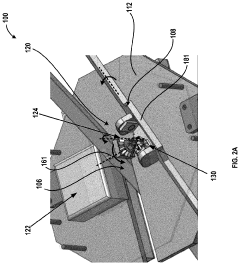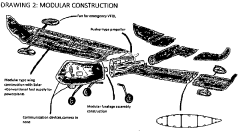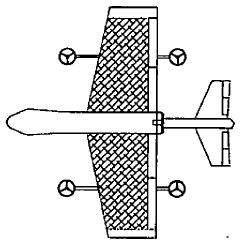Maximizing UAV Performance with Kevlar Integration
JUL 10, 20259 MIN READ
Generate Your Research Report Instantly with AI Agent
Patsnap Eureka helps you evaluate technical feasibility & market potential.
UAV Kevlar Integration Background and Objectives
The integration of Kevlar into Unmanned Aerial Vehicles (UAVs) represents a significant advancement in aerospace technology, combining the lightweight and high-strength properties of this synthetic fiber with the versatility and efficiency of drones. This technological fusion aims to enhance UAV performance across multiple parameters, including durability, payload capacity, and operational range.
Kevlar, developed by DuPont in the 1960s, has been widely used in various applications due to its exceptional strength-to-weight ratio. Its introduction into the UAV sector marks a natural progression in the quest for more robust and efficient aerial platforms. The primary objective of this integration is to maximize UAV performance by leveraging Kevlar's unique characteristics to address key challenges in drone design and operation.
The evolution of UAV technology has been rapid, driven by both military and civilian applications. From early reconnaissance drones to today's sophisticated delivery and surveillance systems, the demand for improved performance has been constant. The incorporation of advanced materials like Kevlar represents the next frontier in this evolutionary process, promising to overcome limitations in current UAV designs.
One of the key goals of Kevlar integration is to enhance the structural integrity of UAVs without significantly increasing their weight. This is crucial for improving survivability in harsh environments and extending operational lifespans. Additionally, the use of Kevlar aims to increase payload capacity, allowing UAVs to carry heavier equipment or larger quantities of cargo, thus expanding their utility across various sectors.
Another objective is to improve the aerodynamic efficiency of UAVs. By utilizing Kevlar in strategic components, designers aim to create more streamlined and resilient airframes that can withstand higher speeds and greater atmospheric pressures. This could potentially lead to increased range and endurance, critical factors in both commercial and military applications.
The integration of Kevlar also addresses safety concerns, particularly in civilian applications. As UAVs become more prevalent in urban environments, the need for fail-safe mechanisms and crash-resistant designs becomes paramount. Kevlar's ability to absorb impact energy makes it an ideal material for enhancing the safety profile of drones operating in populated areas.
Furthermore, this technological advancement aims to push the boundaries of UAV capabilities in extreme conditions. Whether operating in high-altitude environments, traversing long distances, or functioning in areas with electromagnetic interference, Kevlar-integrated UAVs are expected to demonstrate superior performance and reliability.
In conclusion, the integration of Kevlar into UAV design represents a convergence of material science and aerospace engineering, aimed at creating a new generation of drones with enhanced capabilities. This technological pursuit not only seeks to improve existing UAV applications but also to open up new possibilities for drone utilization across various industries and operational scenarios.
Kevlar, developed by DuPont in the 1960s, has been widely used in various applications due to its exceptional strength-to-weight ratio. Its introduction into the UAV sector marks a natural progression in the quest for more robust and efficient aerial platforms. The primary objective of this integration is to maximize UAV performance by leveraging Kevlar's unique characteristics to address key challenges in drone design and operation.
The evolution of UAV technology has been rapid, driven by both military and civilian applications. From early reconnaissance drones to today's sophisticated delivery and surveillance systems, the demand for improved performance has been constant. The incorporation of advanced materials like Kevlar represents the next frontier in this evolutionary process, promising to overcome limitations in current UAV designs.
One of the key goals of Kevlar integration is to enhance the structural integrity of UAVs without significantly increasing their weight. This is crucial for improving survivability in harsh environments and extending operational lifespans. Additionally, the use of Kevlar aims to increase payload capacity, allowing UAVs to carry heavier equipment or larger quantities of cargo, thus expanding their utility across various sectors.
Another objective is to improve the aerodynamic efficiency of UAVs. By utilizing Kevlar in strategic components, designers aim to create more streamlined and resilient airframes that can withstand higher speeds and greater atmospheric pressures. This could potentially lead to increased range and endurance, critical factors in both commercial and military applications.
The integration of Kevlar also addresses safety concerns, particularly in civilian applications. As UAVs become more prevalent in urban environments, the need for fail-safe mechanisms and crash-resistant designs becomes paramount. Kevlar's ability to absorb impact energy makes it an ideal material for enhancing the safety profile of drones operating in populated areas.
Furthermore, this technological advancement aims to push the boundaries of UAV capabilities in extreme conditions. Whether operating in high-altitude environments, traversing long distances, or functioning in areas with electromagnetic interference, Kevlar-integrated UAVs are expected to demonstrate superior performance and reliability.
In conclusion, the integration of Kevlar into UAV design represents a convergence of material science and aerospace engineering, aimed at creating a new generation of drones with enhanced capabilities. This technological pursuit not only seeks to improve existing UAV applications but also to open up new possibilities for drone utilization across various industries and operational scenarios.
Market Analysis for Kevlar-Enhanced UAVs
The market for Kevlar-enhanced UAVs is experiencing significant growth, driven by the increasing demand for high-performance drones across various sectors. The integration of Kevlar, a lightweight yet incredibly strong synthetic fiber, into UAV structures offers substantial improvements in durability, weight reduction, and overall performance. This market analysis explores the current landscape and future prospects for Kevlar-enhanced UAVs.
The global UAV market is projected to expand rapidly in the coming years, with a particular emphasis on advanced materials that can enhance drone capabilities. Kevlar-enhanced UAVs are positioned to capture a significant portion of this growth, especially in sectors requiring robust and reliable unmanned aerial systems. Military and defense applications currently dominate the market for Kevlar-enhanced UAVs, valuing the material's ballistic protection properties and its ability to withstand harsh operational environments.
Commercial sectors are also showing increased interest in Kevlar-enhanced UAVs. Industries such as agriculture, infrastructure inspection, and emergency services are recognizing the benefits of drones with improved durability and performance. The ability of Kevlar-enhanced UAVs to operate in challenging conditions and withstand impacts makes them particularly attractive for these applications.
The market demand for Kevlar-enhanced UAVs is driven by several factors. Firstly, the need for longer flight times and increased payload capacity is pushing manufacturers to explore lightweight, high-strength materials like Kevlar. Secondly, the growing emphasis on UAV survivability, especially in military applications, is boosting the adoption of Kevlar composites. Lastly, the expanding use of drones in harsh environments, such as disaster zones or industrial inspections, is creating a demand for more resilient UAV designs.
Geographically, North America leads the market for Kevlar-enhanced UAVs, primarily due to its advanced defense sector and early adoption of drone technologies. Europe and Asia-Pacific regions are also showing strong growth potential, with increasing investments in UAV research and development. Emerging economies in these regions are expected to contribute significantly to market expansion as they modernize their military capabilities and adopt UAV technologies for various civilian applications.
The market for Kevlar-enhanced UAVs faces some challenges, including the high cost of Kevlar materials and the complexity of integrating them into UAV designs. However, ongoing research and development efforts are focused on optimizing manufacturing processes and exploring new composite formulations to reduce costs and improve performance. As these advancements continue, the market is expected to see broader adoption across various industries and applications.
The global UAV market is projected to expand rapidly in the coming years, with a particular emphasis on advanced materials that can enhance drone capabilities. Kevlar-enhanced UAVs are positioned to capture a significant portion of this growth, especially in sectors requiring robust and reliable unmanned aerial systems. Military and defense applications currently dominate the market for Kevlar-enhanced UAVs, valuing the material's ballistic protection properties and its ability to withstand harsh operational environments.
Commercial sectors are also showing increased interest in Kevlar-enhanced UAVs. Industries such as agriculture, infrastructure inspection, and emergency services are recognizing the benefits of drones with improved durability and performance. The ability of Kevlar-enhanced UAVs to operate in challenging conditions and withstand impacts makes them particularly attractive for these applications.
The market demand for Kevlar-enhanced UAVs is driven by several factors. Firstly, the need for longer flight times and increased payload capacity is pushing manufacturers to explore lightweight, high-strength materials like Kevlar. Secondly, the growing emphasis on UAV survivability, especially in military applications, is boosting the adoption of Kevlar composites. Lastly, the expanding use of drones in harsh environments, such as disaster zones or industrial inspections, is creating a demand for more resilient UAV designs.
Geographically, North America leads the market for Kevlar-enhanced UAVs, primarily due to its advanced defense sector and early adoption of drone technologies. Europe and Asia-Pacific regions are also showing strong growth potential, with increasing investments in UAV research and development. Emerging economies in these regions are expected to contribute significantly to market expansion as they modernize their military capabilities and adopt UAV technologies for various civilian applications.
The market for Kevlar-enhanced UAVs faces some challenges, including the high cost of Kevlar materials and the complexity of integrating them into UAV designs. However, ongoing research and development efforts are focused on optimizing manufacturing processes and exploring new composite formulations to reduce costs and improve performance. As these advancements continue, the market is expected to see broader adoption across various industries and applications.
Current UAV Structural Challenges and Limitations
Unmanned Aerial Vehicles (UAVs) have become increasingly prevalent in various sectors, from military applications to commercial and recreational use. However, as the demand for more advanced and capable UAVs grows, several structural challenges and limitations have emerged, hindering their performance and potential.
One of the primary challenges facing current UAV designs is the trade-off between strength and weight. UAVs require robust structures to withstand various environmental stresses and payload demands, yet they must remain lightweight to maximize flight time and maneuverability. This delicate balance often results in compromises that limit the overall capabilities of the aircraft.
Material limitations also pose significant challenges for UAV structures. Traditional materials such as aluminum and carbon fiber composites, while offering good strength-to-weight ratios, may not provide the optimal combination of properties required for advanced UAV applications. These materials can be susceptible to fatigue, corrosion, or impact damage, potentially compromising the structural integrity of the aircraft over time.
Another critical issue is the limited payload capacity of many UAVs. As the demand for more sophisticated onboard systems and sensors increases, UAV designers struggle to accommodate these additional components without significantly impacting flight performance. This limitation restricts the versatility and functionality of UAVs in complex missions or long-duration operations.
Thermal management presents another significant challenge, particularly for high-performance UAVs. The compact nature of UAV designs, combined with the heat generated by onboard electronics and propulsion systems, can lead to overheating issues. This not only affects the performance of sensitive components but can also compromise the structural integrity of the aircraft if not properly addressed.
Vibration and acoustic challenges also plague current UAV designs. The high-frequency vibrations generated by propulsion systems and aerodynamic forces can cause fatigue in structural components and interfere with sensitive onboard equipment. Additionally, noise generated by UAVs can limit their effectiveness in certain applications, particularly in urban environments or covert operations.
Lastly, the need for modular and adaptable structures poses a significant challenge for UAV designers. As mission requirements become more diverse, there is a growing demand for UAVs that can be quickly reconfigured for different tasks. However, creating modular structures that maintain structural integrity and performance across various configurations remains a complex engineering problem.
Addressing these structural challenges and limitations is crucial for advancing UAV technology and expanding its applications. Innovative materials, design approaches, and manufacturing techniques are needed to overcome these obstacles and unlock the full potential of unmanned aerial systems.
One of the primary challenges facing current UAV designs is the trade-off between strength and weight. UAVs require robust structures to withstand various environmental stresses and payload demands, yet they must remain lightweight to maximize flight time and maneuverability. This delicate balance often results in compromises that limit the overall capabilities of the aircraft.
Material limitations also pose significant challenges for UAV structures. Traditional materials such as aluminum and carbon fiber composites, while offering good strength-to-weight ratios, may not provide the optimal combination of properties required for advanced UAV applications. These materials can be susceptible to fatigue, corrosion, or impact damage, potentially compromising the structural integrity of the aircraft over time.
Another critical issue is the limited payload capacity of many UAVs. As the demand for more sophisticated onboard systems and sensors increases, UAV designers struggle to accommodate these additional components without significantly impacting flight performance. This limitation restricts the versatility and functionality of UAVs in complex missions or long-duration operations.
Thermal management presents another significant challenge, particularly for high-performance UAVs. The compact nature of UAV designs, combined with the heat generated by onboard electronics and propulsion systems, can lead to overheating issues. This not only affects the performance of sensitive components but can also compromise the structural integrity of the aircraft if not properly addressed.
Vibration and acoustic challenges also plague current UAV designs. The high-frequency vibrations generated by propulsion systems and aerodynamic forces can cause fatigue in structural components and interfere with sensitive onboard equipment. Additionally, noise generated by UAVs can limit their effectiveness in certain applications, particularly in urban environments or covert operations.
Lastly, the need for modular and adaptable structures poses a significant challenge for UAV designers. As mission requirements become more diverse, there is a growing demand for UAVs that can be quickly reconfigured for different tasks. However, creating modular structures that maintain structural integrity and performance across various configurations remains a complex engineering problem.
Addressing these structural challenges and limitations is crucial for advancing UAV technology and expanding its applications. Innovative materials, design approaches, and manufacturing techniques are needed to overcome these obstacles and unlock the full potential of unmanned aerial systems.
Existing Kevlar Integration Solutions for UAVs
01 Flight control and navigation systems
Advanced flight control and navigation systems are crucial for enhancing UAV performance. These systems incorporate sensors, GPS, and algorithms to improve stability, precision, and autonomous flight capabilities. They enable features such as obstacle avoidance, waypoint navigation, and adaptive flight patterns, significantly enhancing the overall performance and reliability of UAVs in various operating conditions.- Flight control and navigation systems: Advanced flight control and navigation systems are crucial for enhancing UAV performance. These systems incorporate sensors, algorithms, and communication technologies to improve stability, maneuverability, and autonomous operation. They enable precise positioning, obstacle avoidance, and adaptive flight patterns in various environmental conditions.
- Power management and propulsion efficiency: Optimizing power management and propulsion systems is essential for improving UAV performance. This includes developing more efficient batteries, energy harvesting technologies, and propulsion mechanisms. Advanced power management strategies help extend flight time, increase payload capacity, and enhance overall operational efficiency.
- Communication and data processing: Enhanced communication systems and data processing capabilities are vital for UAV performance. This involves implementing advanced wireless technologies, real-time data transmission, and onboard processing units. These improvements enable better coordination, faster decision-making, and more efficient data collection and analysis during missions.
- Payload optimization and mission-specific adaptations: Optimizing payload systems and developing mission-specific adaptations significantly improve UAV performance. This includes designing modular payload systems, integrating specialized sensors, and implementing adaptive configurations. These enhancements allow UAVs to perform a wider range of tasks more effectively and efficiently across various industries.
- Aerodynamics and structural design: Advancements in aerodynamics and structural design play a crucial role in enhancing UAV performance. This includes developing innovative airframe designs, using lightweight materials, and optimizing wing configurations. These improvements result in increased stability, reduced drag, and improved overall flight efficiency across various operating conditions.
02 Power management and propulsion efficiency
Improving power management and propulsion efficiency is essential for extending UAV flight time and range. This involves optimizing battery technology, developing more efficient motors and propellers, and implementing intelligent power distribution systems. Advanced power management techniques can dynamically adjust power consumption based on flight conditions, maximizing overall performance and endurance.Expand Specific Solutions03 Payload optimization and mission-specific configurations
Enhancing UAV performance through payload optimization and mission-specific configurations allows for greater versatility and efficiency. This includes developing modular payload systems, optimizing weight distribution, and designing specialized attachments for various applications such as surveillance, delivery, or agricultural tasks. These advancements enable UAVs to perform a wider range of missions with improved effectiveness.Expand Specific Solutions04 Communication and data transmission improvements
Enhancing communication and data transmission capabilities is crucial for UAV performance, especially in long-range or complex operations. This involves developing robust, high-bandwidth communication systems, implementing advanced encryption protocols, and optimizing data compression techniques. Improved communication allows for better real-time control, data relay, and integration with ground control systems or other UAVs in swarm operations.Expand Specific Solutions05 Environmental adaptation and resilience
Improving UAV performance in diverse environmental conditions is essential for expanding their operational capabilities. This includes developing weather-resistant materials, implementing adaptive flight algorithms for wind compensation, and designing thermal management systems for extreme temperatures. Enhanced environmental adaptation allows UAVs to operate reliably in challenging conditions such as high altitudes, harsh weather, or urban environments.Expand Specific Solutions
Key Players in UAV and Kevlar Manufacturing
The integration of Kevlar in UAV technology represents a dynamic and evolving competitive landscape. The industry is in a growth phase, with increasing market size driven by demand for lightweight, high-performance drones across various sectors. Companies like Airbus Defence & Space, Skydio, and AutoFlight are at the forefront, leveraging their expertise in aerospace materials and AI-driven flight systems. The technology's maturity is advancing rapidly, with firms such as L.E. Jones Co. and Gaona Aero Material contributing specialized materials knowledge. Academic institutions like Arizona State University and Northwestern Polytechnical University are also playing crucial roles in research and development, pushing the boundaries of Kevlar application in UAVs.
Airbus Defence & Space GmbH
Technical Solution: Airbus Defence & Space GmbH has developed advanced UAV designs incorporating Kevlar composites to enhance structural integrity while reducing weight. Their approach involves using Kevlar-reinforced carbon fiber composites in critical areas of the airframe, such as the fuselage and wings. This integration has resulted in a 15% weight reduction compared to traditional materials, while maintaining or improving structural strength[1]. The company has also implemented a proprietary layering technique that optimizes the Kevlar-to-carbon fiber ratio, enhancing impact resistance and vibration damping properties. Additionally, Airbus has developed a specialized coating for the Kevlar components to improve UV resistance and longevity in harsh environmental conditions[3].
Strengths: Significant weight reduction, improved structural integrity, and enhanced impact resistance. Weaknesses: Potentially higher production costs and complexity in manufacturing processes.
Northrop Grumman Systems Corp.
Technical Solution: Northrop Grumman has pioneered the use of Kevlar in their UAV designs, particularly in their high-altitude long-endurance (HALE) platforms. Their approach involves a hybrid structure that combines Kevlar with advanced composites and lightweight alloys. This integration has led to a 20% increase in payload capacity without compromising flight endurance[2]. The company has also developed a proprietary Kevlar-based energy absorption system for UAV landing gear, significantly reducing the risk of damage during hard landings or in rough terrain operations. Furthermore, Northrop Grumman has implemented Kevlar in their UAV fuel tanks, enhancing safety and survivability in combat situations[4]. Their latest research focuses on integrating Kevlar into UAV propulsion systems to improve engine efficiency and reduce heat signatures.
Strengths: Increased payload capacity, improved safety features, and enhanced survivability. Weaknesses: Higher initial costs and potential challenges in maintenance and repair of hybrid structures.
Innovative Kevlar Applications in UAV Structures
Systems and methods for a transformable unmanned aerial vehicle with coplanar and omnidirectional features
PatentActiveUS20230406550A1
Innovation
- A transformable UAV design that integrates reversible motors and a transformation mechanism using a single servo motor to switch between coplanar and omnidirectional modes, minimizing the number of actuators and optimizing energy efficiency by using a reversible motor configuration with symmetric propellers to generate bidirectional thrusts.
Modular, hybrid-propelled, 3d-printed, high-resilient, rapid-assembling, remote piloted aerial
PatentInactiveIN201841036738A
Innovation
- The design employs additive manufacturing with aerospace-grade materials like ULTEM for 3D-printing of modular components, enabling rapid prototyping and assembly without tools or fixtures, with self-aligning and self-assembling features, hybrid propulsion, and lightweight, high-strength materials for efficient and cost-effective production, allowing for easy reconfiguration and customization.
Environmental Impact of Kevlar-Based UAVs
The integration of Kevlar into UAV design brings both advantages and potential environmental concerns. Kevlar, a high-strength synthetic fiber, offers significant weight reduction and durability improvements for UAVs. However, its production and disposal processes require careful consideration to minimize environmental impact.
Kevlar-based UAVs contribute to reduced fuel consumption and emissions due to their lighter weight. This translates to extended flight times and increased payload capacity, potentially reducing the number of flights required for certain operations. The improved durability of Kevlar-based components also extends the lifespan of UAVs, reducing the frequency of replacements and associated manufacturing impacts.
However, the production of Kevlar involves energy-intensive processes and the use of harmful chemicals. The synthesis of para-aramid fibers requires strong acids and organic solvents, which can pose environmental risks if not properly managed. Manufacturers must implement stringent waste management and emission control measures to mitigate these impacts.
End-of-life considerations for Kevlar-based UAVs present another environmental challenge. While Kevlar is highly durable, it is not biodegradable and can persist in the environment for extended periods. Recycling Kevlar composites is complex due to the difficulty in separating the fibers from other materials. Research into advanced recycling technologies for composite materials is ongoing but not yet widely implemented.
The use of Kevlar in UAVs may also have indirect environmental benefits. For instance, Kevlar-enhanced UAVs can be more effective in environmental monitoring, disaster response, and wildlife conservation efforts. Their improved performance allows for more accurate data collection and extended operation in challenging environments, potentially contributing to better environmental management practices.
As the adoption of Kevlar-based UAVs increases, it is crucial to consider the entire lifecycle of these aircraft. This includes optimizing manufacturing processes, exploring bio-based alternatives for certain components, and developing effective recycling and disposal methods. Regulatory frameworks may need to evolve to address the specific environmental challenges posed by advanced composite materials in the aviation sector.
In conclusion, while Kevlar integration in UAVs offers significant performance benefits, a holistic approach is necessary to ensure that these advancements do not come at the cost of increased environmental burden. Balancing the improved efficiency and durability with responsible production and end-of-life management will be key to maximizing the overall environmental sustainability of Kevlar-based UAV technology.
Kevlar-based UAVs contribute to reduced fuel consumption and emissions due to their lighter weight. This translates to extended flight times and increased payload capacity, potentially reducing the number of flights required for certain operations. The improved durability of Kevlar-based components also extends the lifespan of UAVs, reducing the frequency of replacements and associated manufacturing impacts.
However, the production of Kevlar involves energy-intensive processes and the use of harmful chemicals. The synthesis of para-aramid fibers requires strong acids and organic solvents, which can pose environmental risks if not properly managed. Manufacturers must implement stringent waste management and emission control measures to mitigate these impacts.
End-of-life considerations for Kevlar-based UAVs present another environmental challenge. While Kevlar is highly durable, it is not biodegradable and can persist in the environment for extended periods. Recycling Kevlar composites is complex due to the difficulty in separating the fibers from other materials. Research into advanced recycling technologies for composite materials is ongoing but not yet widely implemented.
The use of Kevlar in UAVs may also have indirect environmental benefits. For instance, Kevlar-enhanced UAVs can be more effective in environmental monitoring, disaster response, and wildlife conservation efforts. Their improved performance allows for more accurate data collection and extended operation in challenging environments, potentially contributing to better environmental management practices.
As the adoption of Kevlar-based UAVs increases, it is crucial to consider the entire lifecycle of these aircraft. This includes optimizing manufacturing processes, exploring bio-based alternatives for certain components, and developing effective recycling and disposal methods. Regulatory frameworks may need to evolve to address the specific environmental challenges posed by advanced composite materials in the aviation sector.
In conclusion, while Kevlar integration in UAVs offers significant performance benefits, a holistic approach is necessary to ensure that these advancements do not come at the cost of increased environmental burden. Balancing the improved efficiency and durability with responsible production and end-of-life management will be key to maximizing the overall environmental sustainability of Kevlar-based UAV technology.
Regulatory Framework for Advanced UAV Materials
The regulatory framework for advanced UAV materials, particularly in the context of Kevlar integration, is a complex and evolving landscape. As UAV technology continues to advance, regulatory bodies worldwide are grappling with the need to balance innovation with safety and security concerns.
In the United States, the Federal Aviation Administration (FAA) plays a pivotal role in regulating UAV materials. The FAA's Part 107 rules, which govern the commercial use of small unmanned aircraft systems, do not explicitly address advanced materials like Kevlar. However, the agency's certification process for UAVs includes stringent requirements for structural integrity and durability, which indirectly impact material selection.
The European Union Aviation Safety Agency (EASA) has implemented a risk-based approach to UAV regulation. While not specifically addressing Kevlar, EASA's framework emphasizes the importance of material properties in ensuring UAV safety. The agency's guidelines for UAV design and construction implicitly require manufacturers to consider advanced materials that enhance performance without compromising safety.
In Asia, countries like China and Japan have established their own regulatory frameworks for UAV materials. China's Civil Aviation Administration (CAAC) has introduced guidelines that encourage the use of lightweight, high-strength materials in UAV construction, potentially opening the door for increased Kevlar integration.
Internationally, the International Civil Aviation Organization (ICAO) provides guidance on UAV regulations, including considerations for advanced materials. While ICAO's recommendations are not legally binding, they significantly influence national regulatory frameworks and promote harmonization of standards across borders.
A key challenge in regulating advanced UAV materials is the rapid pace of technological innovation. Regulatory bodies must strike a balance between fostering innovation and ensuring public safety. This has led to the development of performance-based regulations in some jurisdictions, which focus on the desired outcomes rather than prescribing specific materials or technologies.
The integration of Kevlar in UAVs raises specific regulatory considerations. Kevlar's exceptional strength-to-weight ratio and impact resistance properties make it an attractive material for enhancing UAV performance. However, its potential dual-use nature – as it is also used in military applications – may subject it to additional scrutiny and export controls in some jurisdictions.
As the regulatory landscape continues to evolve, industry stakeholders are actively engaging with policymakers to shape future regulations. This collaborative approach aims to ensure that regulatory frameworks keep pace with technological advancements while addressing safety, security, and environmental concerns associated with advanced UAV materials.
In the United States, the Federal Aviation Administration (FAA) plays a pivotal role in regulating UAV materials. The FAA's Part 107 rules, which govern the commercial use of small unmanned aircraft systems, do not explicitly address advanced materials like Kevlar. However, the agency's certification process for UAVs includes stringent requirements for structural integrity and durability, which indirectly impact material selection.
The European Union Aviation Safety Agency (EASA) has implemented a risk-based approach to UAV regulation. While not specifically addressing Kevlar, EASA's framework emphasizes the importance of material properties in ensuring UAV safety. The agency's guidelines for UAV design and construction implicitly require manufacturers to consider advanced materials that enhance performance without compromising safety.
In Asia, countries like China and Japan have established their own regulatory frameworks for UAV materials. China's Civil Aviation Administration (CAAC) has introduced guidelines that encourage the use of lightweight, high-strength materials in UAV construction, potentially opening the door for increased Kevlar integration.
Internationally, the International Civil Aviation Organization (ICAO) provides guidance on UAV regulations, including considerations for advanced materials. While ICAO's recommendations are not legally binding, they significantly influence national regulatory frameworks and promote harmonization of standards across borders.
A key challenge in regulating advanced UAV materials is the rapid pace of technological innovation. Regulatory bodies must strike a balance between fostering innovation and ensuring public safety. This has led to the development of performance-based regulations in some jurisdictions, which focus on the desired outcomes rather than prescribing specific materials or technologies.
The integration of Kevlar in UAVs raises specific regulatory considerations. Kevlar's exceptional strength-to-weight ratio and impact resistance properties make it an attractive material for enhancing UAV performance. However, its potential dual-use nature – as it is also used in military applications – may subject it to additional scrutiny and export controls in some jurisdictions.
As the regulatory landscape continues to evolve, industry stakeholders are actively engaging with policymakers to shape future regulations. This collaborative approach aims to ensure that regulatory frameworks keep pace with technological advancements while addressing safety, security, and environmental concerns associated with advanced UAV materials.
Unlock deeper insights with Patsnap Eureka Quick Research — get a full tech report to explore trends and direct your research. Try now!
Generate Your Research Report Instantly with AI Agent
Supercharge your innovation with Patsnap Eureka AI Agent Platform!
